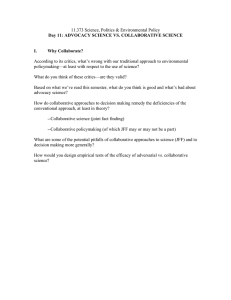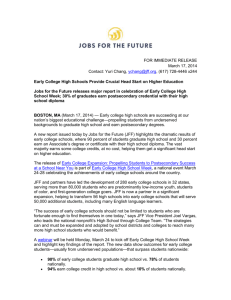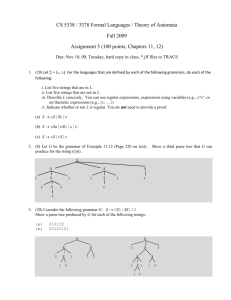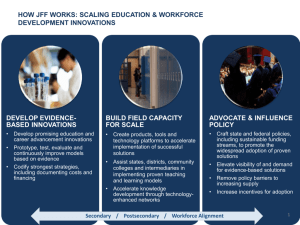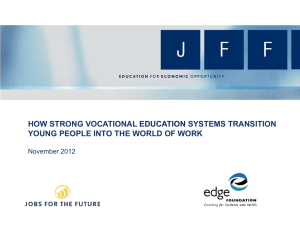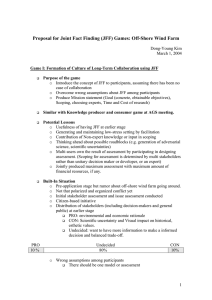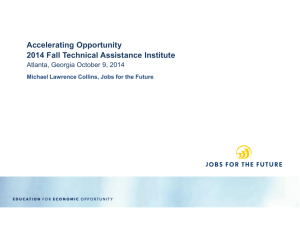I L K J
advertisement
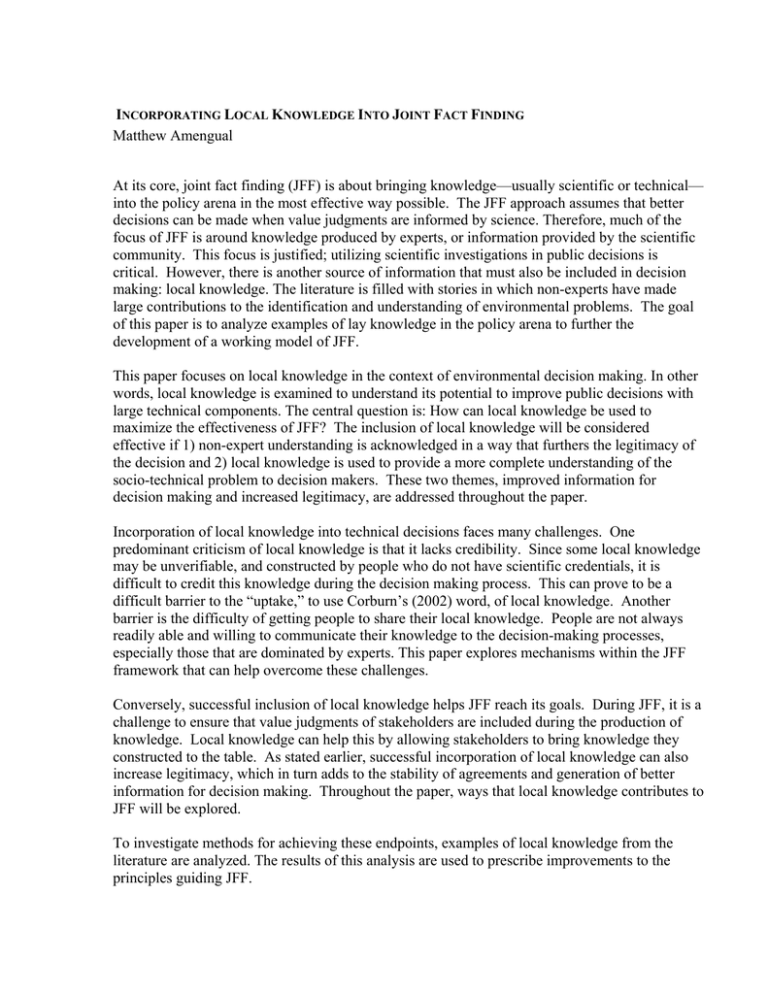
INCORPORATING LOCAL KNOWLEDGE INTO JOINT FACT FINDING Matthew Amengual At its core, joint fact finding (JFF) is about bringing knowledge—usually scientific or technical— into the policy arena in the most effective way possible. The JFF approach assumes that better decisions can be made when value judgments are informed by science. Therefore, much of the focus of JFF is around knowledge produced by experts, or information provided by the scientific community. This focus is justified; utilizing scientific investigations in public decisions is critical. However, there is another source of information that must also be included in decision making: local knowledge. The literature is filled with stories in which non-experts have made large contributions to the identification and understanding of environmental problems. The goal of this paper is to analyze examples of lay knowledge in the policy arena to further the development of a working model of JFF. This paper focuses on local knowledge in the context of environmental decision making. In other words, local knowledge is examined to understand its potential to improve public decisions with large technical components. The central question is: How can local knowledge be used to maximize the effectiveness of JFF? The inclusion of local knowledge will be considered effective if 1) non-expert understanding is acknowledged in a way that furthers the legitimacy of the decision and 2) local knowledge is used to provide a more complete understanding of the socio-technical problem to decision makers. These two themes, improved information for decision making and increased legitimacy, are addressed throughout the paper. Incorporation of local knowledge into technical decisions faces many challenges. One predominant criticism of local knowledge is that it lacks credibility. Since some local knowledge may be unverifiable, and constructed by people who do not have scientific credentials, it is difficult to credit this knowledge during the decision making process. This can prove to be a difficult barrier to the “uptake,” to use Corburn’s (2002) word, of local knowledge. Another barrier is the difficulty of getting people to share their local knowledge. People are not always readily able and willing to communicate their knowledge to the decision-making processes, especially those that are dominated by experts. This paper explores mechanisms within the JFF framework that can help overcome these challenges. Conversely, successful inclusion of local knowledge helps JFF reach its goals. During JFF, it is a challenge to ensure that value judgments of stakeholders are included during the production of knowledge. Local knowledge can help this by allowing stakeholders to bring knowledge they constructed to the table. As stated earlier, successful incorporation of local knowledge can also increase legitimacy, which in turn adds to the stability of agreements and generation of better information for decision making. Throughout the paper, ways that local knowledge contributes to JFF will be explored. To investigate methods for achieving these endpoints, examples of local knowledge from the literature are analyzed. The results of this analysis are used to prescribe improvements to the principles guiding JFF. Joint Fact Finding At this point, is prudent to describe a general JFF model and outline some of its core aspects. Implicit in JFF is a recognition of the importance of the public in technical decisions. The value of bottom-up process stems from embracing direct democracy and rejecting top-down technocratic rationalism. Inclusion of local knowledge enriches the bottom-up approach not only by democratizing analysis allowing the public to influence the construction of knowledge, but also by considering knowledge constructed by the public as part of the decision-making process. Inclusion of different types of knowledge "...may increase the number of players in the environmental policy debate but it will not change how the game is played" (Eden, 1996). JFF changes the way the game is played, making the involvement of these additional players more meaningful. More specifically, JFF is a mechanism for producing information for decision making through consensus building. In this discussion, JFF will be used to label the entire decision-making process, although the focus of the analysis will be on the generation of information. It is useful to discuss JFF’s critique of the traditional decision making process to obtain a clearer idea of its goals. JFF is a mechanism for avoiding adversarial science. It mitigates difficulties that arise when decision makers have to decide between contradictory findings presented by experts. It also inhibits the use of technical information to veil a group’s values by actively managing value judgments that are implicit in an analysis. JFF goes beyond public hearings where people are asked to comment on public policies and are then ignored. By avoiding the pitfalls of the traditional decision-making process, JFF leads to more meaningful public involvement. JFF takes a consensus-building approach to construct a common understanding of a problem. Disagreements over science are segregated from value disagreements. Knowledge is jointly constructed by stakeholders and experts instead of just reported by experts to stakeholders. A procedural outline of JFF illustrates this concept: 1. There is recognition that a decision must be made, and a neutral is identified to mediate the JFF process. 2. The neutral brings together stakeholders. 3. The stakeholders define the problem and identify experts to aid in the decision. 4. Jointly, stakeholders and experts identify research that must be undertaken to inform the decision. 5. Through an iterative process of deliberation among stakeholders and experts, a common understanding of the technical issues is agreed upon. 6. Using this common understanding, stakeholders make the decision. This is a highly simplified model, but lays the foundation for the discussion of incorporating local knowledge into JFF. Again, the critical aspect of JFF is that information enters the decision-making process in way that is controlled by all of the stakeholders. This information may come from experts, and it may come from stakeholders. Local knowledge is regarded as one of several legitimate sources of information. 1 Introduction to Local Knowledge For the purposes of this paper, it is not useful to fully explore different types of knowledge and review the sociological critique of science; however, it is necessary to formally define local knowledge. Local knowledge, sometimes called indigenous knowledge, or lay knowledge, can be defined in the context of JFF by its origin: knowledge produced by non-expert participants. The word “local” implies that this knowledge is developed by people in close proximity to a place or system who have direct experience with the place or the system that will be affected by the decision. However, focusing on the origin of the knowledge downplays its depth: Corburn (2002) stated: "Generally, local knowledge can be understood as the scripts, images, narratives and understandings we use to make sense of the world in which we live." This description asserts that local knowledge is much more than just details that people know about their environment from living and working in it. To bring this definition into the context of JFF, local knowledge can be seen as the way non-experts understand a problem or system, along with the factual information that they bring to the table. The description of local knowledge laid out in this section is broad, but sufficient for now. Throughout the paper, empirical examples will further illustrate what is meant by the term “local knowledge.” Examples and Functions of Local Knowledge This section of the paper uses secondary data from case studies to demonstrate the value of local knowledge in decision making and to further the development of JFF. Local knowledge is categorized by its functions in the decision-making process. These categories help bring some detail to discussions of how local knowledge adds legitimacy and quality information to decisions, and how JFF can be designed to ensure that local knowledge is used in a meaningful way. While these categories are not mutually exclusive, they represent different depths at which local knowledge can be used to critique expertly constructed information. They detail local knowledge, but remain sufficiently broad to encompass situations that may affect JFF in different ways. Some examples of local knowledge in this paper have multiple functions; for clarity and breadth, this analysis uses different examples to illustrate each function. Finally, in order to illustrate the breadth of application for local knowledge, more examples are used and detail is sacrificed. Each example shows how local knowledge is important to consider in decision making. Of previous categorizations of local knowledge, two are particularly important. Eden (1996), in considering what lay people may bring to policy making, describes three functions of local knowledge: Firstly, they would offer “local knowledge”, grounded in their own experiences and observations. Secondly, they would develop “contextual knowledge” through holistically linking factors that science has traditionally separated, e.g. data collection and interpretation. Thirdly, they would involve “active knowledge” which relates to practical actions 2 and action situations, reinforcing the necessity of linking policy design and implementation through behavioral considerations. These categories outline different functions that local knowledge can have. “Contextual knowledge” is particularly supportive of JFF goals because it contributes to effective deliberation. In JFF, the stakeholders may have to reconcile analyses conducted by disagreeing experts in addition to integrating different aspects of analyses. Contextual links between design and practice are useful for the generation of policies that are implementable, and therefore, more stable. Corburn (2002) examines local knowledge in another way. He asserts that local knowledge is important for four reasons: (a) Epistemology - local knowledge makes a cognitive contribution by rectifying the tendency towards reductionism in professional vision and policy; (b) Procedural Democracy - local knowledge contributes additional and previously excluded voices, which can promote wider acceptance of decisions by fostering a “hybridizing” of professional discourse with local expertise; (c) Efficiency - local knowledge can point out low-cost and more efficient policy analysis and implementation options; and (d) Distributive Justice - local knowledge can raise previously unacknowledged distributive justice concerns facing disadvantaged communities. As with Eden’s analysis, Corburn’s functions of local knowledge clearly further the goals of JFF. Notably, the procedural democracy and epistemological functions of local knowledge directly support the goals of stable decisions utilizing the best information possible. These two analyses of local knowledge begin to demonstrate in more detail the potential that local knowledge has to support JFF. I choose a slightly different suite of functions, with the explicit goal of linking local knowledge to the principles of JFF. My functions are centered around information that local knowledge brings to decision making, and the critique it makes of expert knowledge. 1) Scope of the investigation: Local knowledge can inform the scope of the investigation, bringing to light things that may have been overlooked by experts. 2) Knowledge that adds information to existing expert analysis: During analysis, local knowledge can provide information that adds to expert analysis without critiquing the experts’ general research framework. 3) Knowledge of unique aspects of systems and locations: Local knowledge can provide unique information about locations and systems that may be missed in scientific generalizations. Here, the critique that local knowledge offers is deeper than in the previous function. Locals are not only providing information about their community, they are also asserting that there is something about the location or system that could not be ascertained through expert analysis. 3 4) Lay critique of the expert forms of analysis: Local knowledge can sometimes provide information that comes from different ways of knowing a system or location. This is where local knowledge offers its deepest critique of expert knowledge: by contributing ways to understand the world other than scientific, quantitative, and reductionist methods. For example, this can include the use of induction rather than deduction. The remainder of this section describes each of these categories, or functions, in more detail through examples. Once again, the functions are not mutually exclusive; the same local knowledge can affect the scope of an investigation and describe unique aspects of a location. The functions do, however, serve as a way to describe in detail different ways local knowledge contributes to understanding technical problems. Scope of Investigation One of the most important steps in science-intensive disputes is determining the scope of issues to be included in the analysis. For example, in the current controversy over a proposed wind farm in Nantucket Sound, the scale at which impacts are analyzed is critical. There is a large difference between an analysis of the environmental impacts focused on the footprint of the wind farm and an analysis of the impacts on the region— including those from deferred electricity generation from fossil-fuel-burning power plants. The following two examples focus on the influence of local knowledge on the scope of the investigation. Petts’ (1997) description of the development of a plan to manage solid waste in the United Kingdom provides an example of how local knowledge can influence scope. In a community in England, a controversy began as a result of the application of a waste incinerator to expand its operations. The application was met with local opposition, which successfully blocked the expansion. This controversy spurned a broader debate on waste management which involved public input through the formation of “community advisory forums” (Petts 1997). Public input on proposed ways to manage waste led to the consideration of a larger number of issues than experts initially identified, thereby increasing the scope of the investigation leading to the plan. The public’s input stemmed from “personal knowledge, personal experience (particularly of recycling or of living close to a facility), and exposure to other sources of information including the media and activist groups.” For example, from discussions with community members, issues ranging from the “lack of a policy on hazardous household waste” to questions of “whether facilities can be closed down in the event of problems” were identified and considered in the creation of the final plan. Further pushing the scope of the analyses, the lay participants requested that experts investigate additional concerns. For example, the public was concerned about the health implications of different plans, and advocated for lon- term health studies—an action that changed the scope of the studies leading up to the plan (Petts 1997). In summary, local knowledge challenged expertise in the creation of the waste management plan and increased the scope of options considered, resulting in an improved 4 final plan. The mechanism for public involvement, while not perfect, was able to facilitate uptake by experts. Finally, the credibility of both local knowledge among experts, and expert knowledge among the lay public, was improved through dialogue. Corburn (2002) describes an instance in which local knowledge greatly informed the scope of a health risk assessment conducted in Brooklyn, New York, by the Environmental Protection Agency (EPA). The EPA initially developed a methodology for a cumulative risk assessment without consulting the community. The EPA did, however, provide one opportunity for public involvement at a community meeting. At this meeting, residents of the neighborhood articulated concerns they had with the methodology; most notably, the omission of consumption of fish from a local waterway—the East River. The EPA estimated exposure from toxics in food, but the EPA did not include fish from local waterways in the study. Members of the community “argued that without the angler information, the CEP [cumulative exposure project] would miss a potentially hazardous exposure” (Corburn 2002). The local knowledge, knowing that people ate fish from the East River, identified a significant oversight in the scope of the EPA’s proposed analysis. In this case, the use of local knowledge went beyond the initial recognition of an additional risk left out of the EPA’s scope. With the support of the EPA, the activists conducted a survey of anglers who fished the East River. Corburn (2002) asserts that local knowledge improved decision making by “(a) adding data sources such as angler information; (b) providing access to difficult to reach informants; (c) bridging linguistic differences, by relying on non-English speakers; and (d) counteracting disincentives of informants to participate due to poverty, culture, fear and defensiveness.” The findings from the survey indicated that the EPA would have missed a large risk for a portion of the population. The local knowledge caused the EPA to create a separate risk assessment for people who fished in East River. This example demonstrates how local knowledge can influence the scope of studies leading to a better understanding of environmental issues. In this example, the local knowledge was accepted, despite the fact that it was initially in at odds with the expert analysis. Verification was able to take place through methods that were co-created by lay people and experts. The end result, a study that addressed eating fish from local waterways, was clearly better than the study that was initially proposed. Knowledge that Adds Information to Existing Expert Analysis People who have direct experience with a location or system can provide detailed information about that system. This information can be used when expertly created information is not available, or to augment expert information when it is available. Experiential knowledge can be important even when a system is not unique, distinguishing it from the function that is discussed in the next section—identifying unique aspects of places and systems. This information can be particularly useful when no baseline studies have been conducted, and historic data has not been collected. In these cases, expert-driven data collection may be impossible, or prohibited by cost or time. 5 In Australia, Robertson and McGee (2003) show that local knowledge was utilized to help understand flooding in the Kanyapella Basin, a large wetland. In this case, information about the past flooding, ecology and management of the basin, which was necessary for managing the system, was unknown to experts. To fill these gaps, researchers used the oral history of people who had "on the ground experience" with the basin (Robertson and McGee 2003). The method of incorporating local knowledge was through interviews conducted with residents and local managers. The results of these interviews were combined with expert knowledge to develop a more precise understanding of the history of the basin. The oral histories specifically dealt with flooding, flora and fauna, and historic management. In this case, local knowledge provider information at a level of detail that expert studies could not ascertain due to methodological constraints. For example, expert studies were unable to identify minor historic flooding that locals witnessed. Local landowners were also able to identify causal effects of water management, including the relationship between flooding and the death of eucalyptus trees through experiential knowledge. In fact, some residents were able to account for events that happened 50 years earlier. In addition to the lack of scientific information, no documentation on historic management of the basin existed and local knowledge was able to provide a history of management strategies and their effectiveness. Efforts were made to verify local knowledge with aerial photographs, existing scientific knowledge, and other historic information. Using these comparisons, inaccuracies were identified in some cases. Robertson and McGee (2003) assert that insight was obtained through integration of different forms of knowledge. In some cases, local knowledge identified possibilities that were confirmed through scientific investigation. This echoes the discussion above of examples of how local knowledge impacted the scope of investigations. In the end, "The inclusion of oral history has clearly contributed to the future management and rehabilitation of the Kanyapella Basin. The oral history was instrumental...in identifying knowledge gaps where research is required" (Robertson & McGee 2003). Also, the public, whose knowledge was solicited, perceived that they had a greater role in the subsequent creation of the restoration plan. This increased the legitimacy of the plan, even though the plan itself did not a result from a consensus among members of the public. This example clearly illustrates how knowledge that people have from direct experiences in a place or a system can be used to make better decisions. Additionally, in this case, the use of local knowledge increased legitimacy of the policy. Local knowledge was able to be verified, and sometimes discredited, by triangulating it with expert knowledge and other local knowledge. Scientific knowledge often involves making generalizations about systems. These generalizations are necessary, but can sometimes lead experts to miss unique aspects of systems that may be critical. This can be due to aggregation—limiting detail to a manageable amount of information—or assuming that one location is like other locations. This function offers a deeper critique because local knowledge provides information that 6 experts would not identify through their studies despite the fact that the scope of the questions being asked is essentially on target. The following two examples highlight how local knowledge can contribute unique and detailed information that was instrumental for quality decision making. Wynne’s (1996) account of radioactive contamination of sheep farms in England provides a good illustration how local knowledge can contribute to the understanding of a unique location. In this case, experts failed to take local knowledge into account, which resulted in the creation of incorrect policy responses that later needed to be corrected. Following the 1986 Chernobyl accident, sales and the movement of sheep in an area of England were restricted by government officials because of radioactive contamination. This restriction alarmed farmers because it put the sheep farming industry in jeopardy. Farmers were unable to sell their sheep or move them to suitable grazing grounds. The radioactive contamination came from radiocesium, which scientists thought would only affect the sheep for a short time. Initially, the government estimated that the restrictions would only be in place for three weeks. However, when the contamination did not decrease, the ban continued past the three-week point, presenting a major problem to the farmers who risked losing their flocks. Subsequently, the ban was limited only to selling sheep for slaughter and farmers were allowed to move sheep to adequate grazing grounds. The government eventually allowed the sheep to move to areas that were not contaminated, making them safe for consumption. The expert knowledge that created the original policy could have been improved by relying on local knowledge of the farmers. Wynne (1996) described the error in the scientific understanding: …the scientists had overlooked the essentially localized nature of this knowledge, because clay soil was not a universal condition, and in other soils such as those in the hill areas, very different behavior prevailed. In these areas acid peaty soils predominated, and in such soils radiocesium remains chemically mobile, hence available for root uptake from the soil, back into the vegetation which the sheep grazed. In this case, the degree of the scientists’ aggregation was so large enough that they overlooked unique aspects of the land that were critical for the creation of the correct policy. Local knowledge could have provided the experts with the necessary level of detail. Lack of respect for local knowledge by experts exacerbated the public’s distrust of expert knowledge, and the legitimacy of policies that were created using it. Also, although verification happened after the fact, lay knowledge was eventually accepted. The farmers’ local knowledge was confirmed once the experts corrected their mistakes. Another case detailed in Corburn’s (2002) work on local knowledge describes its contribution to combating asthma. New York City's Department of Environmental Protection (DEP) conducted a study that estimated asthma prevalence among city residents. For a neighborhood in Brooklyn, the study relied on asthma hospitalizations 7 from one particular hospital. The study found that asthma rates in this neighborhood were not significantly higher than in the rest of the city. However, residents knew that the asthma rates were much higher in their neighborhood than the study indicated: People rarely visited this hospital for asthma. To add to the residents concern, this study was released during controversy over the siting of an incinerator in their neighborhood. Following the release of the study, a local group conducted a survey of community health concerns. The results of the survey indicated that asthma was the “number one health concern” in the community (Corburn 2002). The community group then partnered with experts in epidemiology to conduct their own surveys of asthma rates. They found that there were significantly higher rates of asthma in the community than the expert’s study had shown. In one survey, selfreported asthma rates were 12.4 percent, significantly higher than the national average of 5.4 percent (Corburn 2002). In this case, locally generated knowledge was verified in a way that met professional standards: The results of the community group’s studies were published in the American Journal of Public Health. Verification in this case was possible in part because this was an “example of local knowledge extending science, not replacing it” (Corburn 2002). The unique aspect of this community that local knowledge provided was that people did not use professional medical treatment for asthma, which was one of the foundations of the expert study. Moreover, in a community that is largely made up of Puerto Ricans and Dominicans, local surveys found that members of these ethnic groups often rely on home remedies for asthma instead seeking professional medical treatment. “Whether insured or not, over 56 percent of Dominicans and 45 percent of Puerto Ricans had substituted a home-remedy for physician prescribed medicine” (Corburn 2002). This unique situation deepened the local critique of expert knowledge. In summary, local knowledge identified a unique aspect of a neighborhood in Brooklyn that greatly altered estimates of asthma rates by experts. This type of local knowledge is essential for quality studies to inform policy decisions. Lay Critique of the Expert Forms of Analysis In some cases, non-experts have different ways of knowing than experts. Expert knowledge is often quantified, reductionist, mediated through instruments, and reliant on deduction. Local knowledge on the other hand is direct, experiential, and may be inductive. One of the goals of JFF is to reconcile different views of the world through consensus building. To do this effectively, JFF will have to engender recognition of different forms of knowledge by all stakeholders. The following example shows how different forms of understanding a situation can be a barrier to effectiveness and legitimacy of policies. Smith (1995) describes fisheries management in the United States as largely unsuccessful. Fish stock management in the United States is controlled by fisheries councils made up of environmentalists and industry representatives—including 8 fishermen. Smith’s account of these councils is an opportunity to examine how the local knowledge of fishermen has interacted with the expert knowledge of scientists. This case differs from the previous examples because it does address a specific study, but offers a general description of different ways of understanding and their impacts on continuous fisheries management. Smith asserts that the failure of the fisheries councils is due to a fundamental difference between knowledge obtained through scientific investigation and through the practical experience of fishermen. The experts see the fisheries as subject to random fluctuations—but subject to prediction--while the fisherman believe that things happen for a reason—but that the system is unpredictable. Fishermen believe that the research done by scientists fails to take into account the impacts of small events that fisherman believe can cause major changes in fish stocks. The claims made by the fisherman are impossible to verify, further rendering their role in the policy arena more problematic. In these disputes described by Smith fishermen "reject much of the research and analysis because they believe them too insensitive to...realities". In addition, experts saw fisherman as conflating their values with the information they provided. The inability to bridge the gap between the local knowledge of the fisherman and the experts disadvantaged the final policy. Fishermen were likely to learn to deal with regulations by finding ways around them, decreasing the effectiveness of policy implementation. In this case, there is clearly a disparity between the way experts and lay people understand the world. There are “two knowledge cultures,” to borrow Wynne’s (1996) words. In these situations, including local knowledge is especially critical for legitimacy. JFF represents an opportunity to find common ground between knowledge cultures, which will in turn lead to better and more effective policies. Joint Fact-Finding Principles and Local Knowledge Using information gleaned from these examples, it is possible to offer prescriptions for implementation of JFF in a way that takes into account local knowledge. This section discusses principles of JFF adapted from work that was done by the MIT graduate seminar on Joint Fact Finding in the fall of 2003. The goal of these principles is to articulate what must occur for a decision-making process to be considered JFF. These principles will be discussed for two purposes: (a) their relevance to overcoming barriers to including local knowledge in decision making and (b) the way in which inclusion of local knowledge maximizes the efficacy of JFF. The Neutral and Conflict Assessment All JFF processes must be convened by a trusted neutral. The neutral is critical to ensuring that negotiations between the parties proceed in a way that maximizes everyone’s benefits (Susskind 2000). Corburn (2002) notes that one of the conditions for uptake of local knowledge is having an intermediary between the local knowledge and the expert community. In his example of risk assessment described above, the executive director of the community group had the ability to “manage the organizing of local knowledge and its uptake into professional domains” (Corburn 2002). This 9 example reaffirms JFF’s commitment to neutrals. It also adds the active management of local knowledge uptake to the neutral’s responsibilities. The second portion of this principle is conflict assessment. Through the conflict assessment, the neutral identifies areas of agreement and disagreement among the parties. During the conflict assessment, the neutral should also conduct a “knowledge assessment,” identifying what kinds of knowledge people bring to the table. If local knowledge is not recognized, it is impossible for it to become a part of the policy decision. Lay people will not always proactively contribute their knowledge and it is not always obvious to them that local knowledge will be useful. For example, in the account of water management in Australia, the author solicited local knowledge by asking for oral histories from residents and managers. This was the first step to inclusion of this knowledge and should therefore be undertaken at the outset of every JFF process. Common Language To facilitate dialogue, all participants must agree upon common terms or language. This is necessary to bridge the communication gap between experts from different fields and between experts and lay people. Without effective communication, it will be impossible to include local knowledge to in the process. In Smith’s (1995) account of the difficulties of bridging two types of knowledge, the inability for these two groups to communicate frustrated the process. The fishermen were unable to present their view of the fisheries in a way that resonated with experts, which enabled the dismissal of local knowledge. In the Brooklyn example, the ability of community groups to communicate with fishermen enabled their knowledge to be taken into account. The analysis of examples of local knowledge reaffirms this principle of JFF. Stakeholders Select and Dictate the Role of the Technical Team JFF usually requires technical support for the decision-making process. Stakeholders must select the technical team, and determine its role. This principle highlights the need for stakeholder control of technical analysis. In addition to selecting a technical team that has the ability to undertake studies needed for the JFF process, experts should also be selected by their ability to acknowledge different forms of knowledge. Experts that will not respect local knowledge should not participate, or should have intermediaries that will take part in the JFF process. Moreover, when the role of the technical team is outlined for the experts, the need to consider local knowledge must be made explicit. This principle poses a potential problem: finding experts willing to work under these ground rules. Prescriptions for the professional culture of scientists are beyond the scope of this paper. It is apparent, however, from the examples above, that experts must be willing to consider local knowledge. The examples in which the experts recognized the value of local knowledge and worked to include it, were the most successful. Therefore, despite the difficulty in assembling a technical team composed of receptive experts, this goal should still be pursued. 10 Iterative Process of Deliberation During JFF, the inclusion of technical information into the process should happen in an iterative fashion. In other words, the technical team, and those who have local knowledge, should not just deliver the information and then stop taking part in the process. There needs to be deliberation to ensure that the knowledge is co-produced by all stakeholders and the technical team. The process of deliberation, discussing the results of studies with experts is a way of evaluating the weight that stakeholders put in the expert analysis when they make their decisions. It is also a way to ensure that stakeholders get the information they need from the experts. The interaction between stakeholders and experts should be mirrored by a similar interaction between stakeholders and those who are contributing local knowledge. This aspect of JFF presents a solution to the difficulty of verification of local knowledge. In the examples above, local knowledge was verified in a number of ways, including peer review and triangulation with other data sources. The deliberative aspects of JFF should be used to verify local knowledge in a way that satisfies the stakeholders. The extent to which the local knowledge will be held to the same type of standards as knowledge produced by technical experts should be determined by the stakeholders through this deliberation. In some cases, as was shown in the Brooklyn asthma research, this is possible (Corburn 2002). In other cases, such as the water management in Australia, it was not always possible to hold local knowledge to the same standards as expert knowledge but it is still possible to evaluate it. In that case, local knowledge was evaluated by comparing it with expert knowledge. For example, areas of historic flooding identified through oral histories were found to be of low elevation, which did not rigorously verify the information but added to confidence in it (Robertson and McGee 2003). As technical studies are refined in an iterative fashion by stakeholders, they can be altered in a way that will help stakeholders evaluate local knowledge. The dialogue and iterative process in JFF will also serve to ensure that local knowledge is identified and brought into the process. In the examples where local knowledge failed to be taken advantage of, such as Wynne’s description of the contamination of sheep, a process of dialogue to solicit local knowledge did not exist. Therefore, in addition to having the neutral initially identify local knowledge in the conflict assessment stage, local knowledge should be solicited in later dialogue. This reaffirms the need for experts who are willing to consider local knowledge. Explicit Recognition of Values During Technical Decision Making In JFF, values must be explicitly managed. This principle comes from the premise that true objectivity is not necessarily possible—technical decisions will be shaped, at least in part, by the values of those making them. Questions and research can be designed, even if subconsciously, in a way that skews results towards the values of the researchers. Incorporation of local knowledge can facilitate the process of ensuring that stakeholders’ values are included in information production. Non-experts’ values are incorporated into 11 the construction of knowledge when they are empowered to produce information themselves. Differences in knowledge construction that arise from value difference can elucidate these influences allowing for values to be more explicitly managed. Moreover, values are not just about determination of the outcome, but of the type of analysis that needs to be conducted. For example, in the fisheries management case, the different ways of understanding fisheries management reflect different values that need to be taken into account in the JFF process. Corburn (2002) states: By extending science, local knowledge can move science beyond its adherence to “technical rationality” to include “cultural rationality”, in which rationality comes from an equally valid, but more informal logic and trust emerging from the process of knowledge creation. Local knowledge can serve as a way of incorporating these values into analyses, thereby pushing beyond a critique of facts to a critique of paradigms. Framing of Questions by Stakeholders With the aide of the technical team, stakeholders should frame questions that need to be answered during the stakeholder process. Strong adherence to this principle will ensure that local knowledge contributes to scoping of questions. The examples above—risk assessment in Brooklyn and waste management in the U.K.—clearly demonstrate that local knowledge needs to be included when determining the scope of the research conducted in the JFF. Harmonizing the Timeline between Research and Policy Making One difficulty that often occurs when decisions depend on science is that the policy timeline is significantly shorter than the time that it takes to conduct research. During JFF, these two timelines must be reconciled. Local knowledge can contribute to this by inserting knowledge into the decision-making processes that already exist. Local knowledge can act as baseline data, as seen the in water management example above. Also, lay people can collect data, thereby decreasing the time and costs of research. Both examples from Corburn’s (2002) work above show that this can be possible. Conclusion Joint fact finding provides a model for achieving stable and informed policy decisions. The effective inclusion of local knowledge can help JFF achieve its goals. Moreover, JFF has the potential to overcome many barriers to including local knowledge in the policy arena by 1)providing a forum for lay people to provide their knowledge; 2) having an intermediary work to facilitate the inclusion of the knowledge; and 3) providing a forum for verification of the knowledge. The examples analyzed in this paper show that there is a great advantage to incorporating local knowledge, but many barriers as well. A JFF process that is designed to overcome these barriers will be a better process. Employment of this process will increase the likelihood that policy decisions are seen as legitimate by stakeholders and that the decisions account for the best knowledge possible—two core goals of JFF. 12 References Corburn, Jason. 2002. Street Science: The Fusing of Local and Professional Knowledge in Environmental Policy. Doctoral Dissertation, Massachusetts Institute of Technology. Eden, Sally 1996. Public participation in environmental policy: considering scientific, counter-scientific and non-scientific contributions. Public Understanding of Science (5): 183-204. Petts, Judith. 1997. The public-expert interface in local waste management decision: expertise, credibility and process: Public Understanding of Science 6: 359-381. Robertson and McGee. 2003. Applying local knowledge: the contribution of oral history to wetland rehabilitation at Kanyapella Basin, Australia. Journal of Environmental Management, 69: 275-287. Smith, M.E. 1995. Chaos, consensus and common sense. The Ecologist, 25 (2/3): 80-85 Susskind, Lawrence, Paul F. Levy, and Jennifer Thomas-Larmer. 2000. Negotiating Environmental Agreements: How to Avoid Escalating Confrontation, Needless Costs, and Unnecessary Llitigation. Washington, DC: .Island Press. Wynne, Brian. 1996. May sheep safely graze? in Scott Lash, Bronislaw Szerszynski and Brian Wynne (eds.) Risk, Environment and Modernity: Towards a New Ecology Thousand Oaks, CA: Sage Publications. 13

